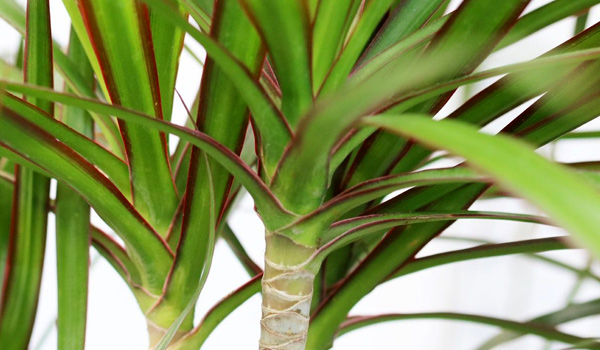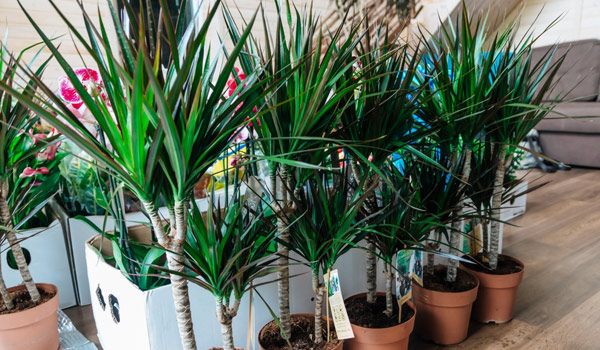Dragon Plant Care & Grow Guide (Dracaena Marginata)

A crowd of bright green leaves with red edges that are shaped like swords. You guessed it, we are talking about the beautiful dracaena marginata, or as we commonly know it dragon plant or Madagascar dragon tree.
This spiky tree is a great candidate as your next houseplant and today we are going to tell you all about its origin, what makes it unique, dragon plant care, propagation, and its common problems.
Dragon Tree Info
Madagascar is the home to this plant, where it grows up to 15 to 20 feet in height and 3 to 10 feet in width when mature. The evergreen dragon plant is a member of the Asparagaceae family and thrives in full sun to partial shade in neutral to acidic soils with proper drainage.
As beautiful as this plant is, it is dangerous for pets as it is toxic to both cats and dogs.
Dragon Plant Flower
When grown indoors, marginata plant rarely blooms. However, if you are lucky, you might be blessed with white flowers in the spring.
Dragon Tree Benefits
Ornamental values are not all that this plant has to offer. Some of the most considerable dragon tree benefits, which are proven in studies include:
- Purifying the air
- Absorbing Lead (Pb)
- Increasing the humidity
- Increasing concentration and sharpening focus
Types of Dragon Plants
Dracaena plant types are not very few, although some of them are more common than others. Let us have a glance at types of dragon plants:
- marginata ‘Bicolor’ that has red and green stripes.
- marginata ‘Tricolor’ has dark red edges and a pale stripe down the center of its green leaves.
- marginata ‘Colorama’ that mirrors the tricolor variety with the three colors on the leaves, but features prominent red bands on the outside edges,
- marginata ‘Tarzan’ that has leaves similar to the original marginata plant, which are slightly tougher, wider, and thicker. Making it easy to identify.

Dragon Tree Care
Without further a due, let us see how we can have the happiest and healthiest dragon plant that there is. In dracaena marginata care, these are the most important requirements to have in mind:
Water
Tolerating drought is one of the things that make this plant quite easy to care for. This feature also makes people often over-water it. To avoid this mistake in dragon plant care, do not water it until the top half of the soil is dry, which takes up to three weeks or more.
Light
Provide a spot with bright light and watch your Madagascar dragon tree thrive. It can also survive and grow in partial shade, but slower. Lower light situations result in producing smaller, less vibrant leaves as well.
While trying to avoid such a location, be careful not to place your plant where it receives direct rays of sunlight; dragon tree’s foliage can burn easily.
Temperature and Humidity
As you can tell by its origin, dracaena plant types prefer warmer temperatures between 70- and 80-degrees Fahrenheit. The average humidity in the house should be fine for them, so you do not need to do anything special.
However, if your house is particularly dry, consider misting the dragon plant lightly every few days.
Soil and Fertilizer
A loose, well-drained potting mix is your best option for dracaena marginata care when growing it in a pot. A mix of loamy soil with peat moss would be ideal.
As a low-maintenance species, the dragon tree plant has a relatively low need for fertilizer. So, to have a thriving plant, you do not have to feed it. If interested in boosting the growth, feed lightly at the beginning of spring with a balanced controlled-release liquid fertilizer. Never fertilize dracaena plant types in the winter.
Potting and Repotting
Always choose a container that has room for marginata plant’s extensive root system. When buying this species, keep in mind that some dracaena plant types are imported from Hawaii and arrive with lava rock. In that case, remove about one-third of the rock and replace it with suitable potting soil.
When the plant outgrows the pot, it is vital to move it to a larger part. But do not worry, since the dragon plant has a slow growth rate, you will only need to repot it only every two or three years. Nevertheless, it is recommended to refresh the potting soil each year to replace the compacted potting mix.
Pruning
The marginata plant itself shed the dead leaves beautifully. All you need to do is pick them up and throw them away. To keep your plant neat, you can take matters in hand by removing the leaves that seem to fall soon.
Additionally, you can cut back stems with sharp pruning shears to trim your Madagascar dragon tree. Do not forget to sterilize the pruning tool with a clean cloth and rubbing alcohol or hydrogen peroxide. After that, rinse with water, wipe it dry, and then prune your plant.

Dracaena Marginata Problems
We mentioned that this plant is susceptible to over-watering. So, if you could avoid that, you will solve at least half of the probable problems.
If you see yellow leaves, it usually means that the plant needs more water. However, if you notice brown tips on its leaves, that usually indicates too much water or using water with too much salt or fluoride that causes discoloration. To avoid this, water your dragon plant with distilled or non-fluoridated water. If the plant has yellow leaves, it usually means it needs more water.
Dragon tree plant is resistant to pests, but some of them like thrips, scale, spider mites, and mealybugs can create difficulties for your plant:
- Spider mites mostly happen when temperatures are warm, and the air is very dry.
- Mealybugs are easy to identify by the sticky, cotton-like deposits that they leave on the leaves.
- Unlike mealybugs, unfortunately, it is challenging to see spider mites until they have already damaged your beautiful dracaena marginata.
Dragon Plant Propagation
Propagating marginata plant using stem cuttings is simple and quick. The spring, when the plant is growing vigorously, is the best time for propagation following these steps:
- Using a sterile, sharp knife or scissor, cut a stem that is about 8 inches.
- Remove all the leaves and plant the cutting in moist potting soil.
- Place the dragon tree plant cutting in allocation with bright, but indirect sunlight.
- Leaves will sprout on the upper cutting’s nodes and its top as a rosette.
The cuttings will sprout in about three weeks and using a rooting hormone is not necessary. Use the young plant to create an attractive decor or give it to friends and family as an adorable gift.
- In this post:
- Dragon Tree Info
- Dragon Tree Care
- Dracaena Marginata Problems
- Dragon Plant Propagation



